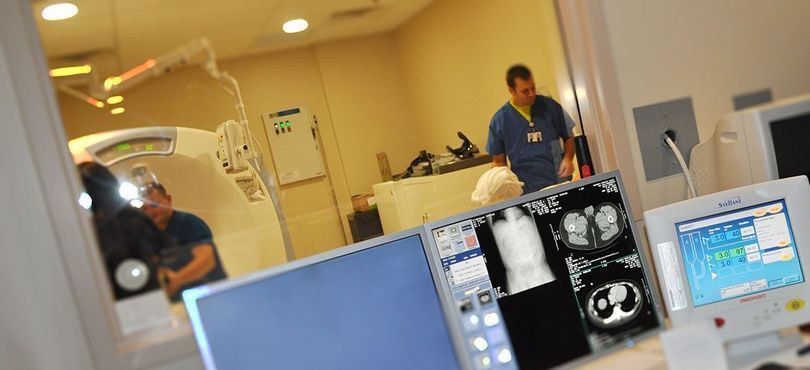What is a CT Scan?
CT scanning—sometimes called CAT scanning—is a noninvasive, painless medical test that helps physicians diagnose and treat medical conditions.
CT imaging uses special X-Ray equipment to produce multiple images or pictures of the inside of the body and a computer to join them together in cross-sectional views of the area being studied. The images can then be examined on a computer monitor or printed.
CT scans of internal organs, bone, soft tissue and blood vessels provide greater clarity than conventional X-Ray exams.
What to expect
You should wear comfortable, loose-fitting clothing to your exam. You may be given a gown to wear during the procedure.
Metal objects including jewelry, eyeglasses, hearing aids, dentures and hairpins may affect the CT images may need to be removed prior to your exam.
You may be asked not to eat or drink anything for several hours beforehand. You should inform your physician of any medications you are taking and if you have any allergies, especially to contrast materials.
Also inform your doctor of any recent illnesses or other medical conditions, and if you have a history of heart disease, asthma, diabetes, kidney disease or thyroid problems. Any of these conditions may increase the risk of an unusual adverse effect.
In many ways CT scanning works very much like other X-Ray examinations. Different body parts absorb the X-Rays in varying degrees. With CT scanning, numerous X-Ray beams and a set of electronic x-ray detectors rotate around you, measuring the amount of radiation being absorbed throughout your body. At the same time, the examination table is moving through the scanner, so that the X-Ray beam follows a spiral path. A special computer program processes this series of pictures, or slices of your body, to create two-dimensional cross-sectional images, which are then displayed on a monitor.
CT imaging is sometimes compared to looking into a loaf of bread by cutting the loaf into thin slices. When the image slices are reassembled by computer software, the result is a very detailed multidimensional view of the body's interior.
Modern CT scanners are so fast that they can scan through large sections of the body in just a few seconds. Such speed is beneficial for all patients but especially children, the elderly and critically ill.
For some CT exams, a contrast material is used to enhance visibility in the area of the body being studied.
How is the CAT scan performed?
The technologist begins by positioning you on the CT examination table. Straps and pillows may be used to help you maintain the correct position and to hold still during the exam.
If a contrast material is used, it will be swallowed, injected through an intravenous line (IV) or administered by enema, depending on the type of examination.
Next, the table will move quickly through the scanner to determine the correct starting position for the scans. Then, the table will move slowly through the machine as the actual CT scanning is performed.
You may be asked to hold your breath during the scanning.
When the examination is completed, you will be asked to wait until the technologist determines that the images are of high enough quality for the radiologist to read.
CT scanning of the body usually lasts between five and 30 minutes.
What will I experience during and after the procedure?
Most CT exams are painless, fast and easy. With spiral CT, the amount of time that the patient needs to lie still is reduced.
Though the scanning itself causes no pain, there may be some discomfort from having to remain still for several minutes. If you have a hard time staying still, are claustrophobic or have chronic pain, you may find a CT exam to be stressful. The physician may offer you a mild sedative to help.
If an intravenous contrast material is used, you will feel a slight pin prick when the needle is inserted into your vein. You may have a warm, flushed sensation during the injection of the contrast materials and a metallic taste in your mouth that lasts for a few minutes. Occasionally, a patient will develop itching and hives, which can be relieved with medication. If you become light-headed or experience difficulty breathing, you should notify the technologist or nurse, as it may indicate a more severe allergic reaction.
If the contrast material is swallowed, you may find the taste mildly unpleasant; however, most patients can easily tolerate it. You can expect to experience a sense of abdominal fullness and an increasing need to expel the liquid if your contrast material is given by enema. In this case, be patient, as the mild discomfort will not last long.
When you enter the CT scanner, special lights may be used to ensure that you are properly positioned. With modern CT scanners, you will hear only slight buzzing, clicking and whirring sounds as the CT scanner revolves around you during the imaging process.
You will be alone in the exam room during the CT scan, however, the technologist will be able to see, hear and speak with you at all times.
With pediatric patients, a parent may be allowed in the room but will be required to wear a lead apron to prevent radiation exposure.
A radiologist, a physician specifically trained to supervise and interpret radiology examinations, will analyze the images and send a signed report to your primary care or referring physician, who will share the results with you.

